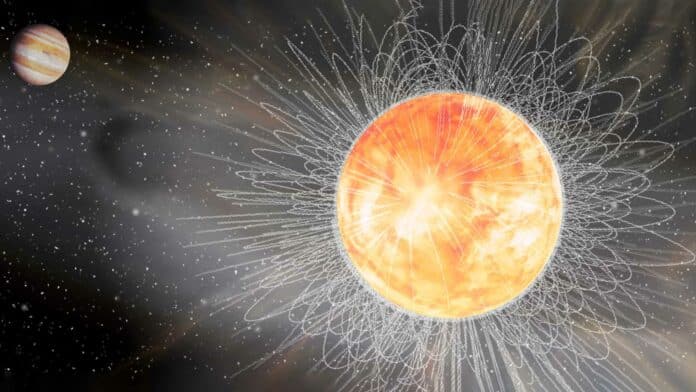In 1995, scientists found a planet outside our solar system around a star called 51 Pegasi. Since then, more than 5500 such planets have been discovered. Recently, astronomers studied 51 Pegasi again and think its current magnetic conditions are good for complex life. They found that stars in their midlife crisis and beyond might be great places to find alien life.
This research is a big deal, giving us new insights into magnetic forces and places where life could exist.
Stars like our Sun start their lives spinning rapidly, generating a strong magnetic field that can unleash intense eruptions affecting their planetary systems. As these stars age over billions of years, their rotation slows due to magnetic braking – a process where the star’s magnetic field interacts with a surface wind, resulting in a weaker magnetic field. Until recently, scientists believed magnetic braking continued indefinitely, but new observations question this long-held assumption.
Team leader Travis Metcalfe, a senior research scientist at White Dwarf Research Corporation in Golden, Colorado, USA, said, “We are rewriting the textbooks on how rotation and magnetism in older stars like the Sun change beyond the middle of their lifetimes.”
Klaus Strassmeier, director at the Leibniz-Institute for Astrophysics in Potsdam, Germany, and co-author of the study, said, “Our results have important consequences for stars with planetary systems and their prospects for developing advanced civilizations. This is because weakened magnetic braking also throttles the stellar wind and makes devastating eruptive events less likely.”
Astronomers used NASA’s Transiting Exoplanet Survey Satellite (TESS) and the Large Binocular Telescope (LBT) in Arizona with the Potsdam Echelle Polarimetric and Spectroscopic Instrument (PEPSI) to study the star 51 Pegasi. While the exoplanet itself doesn’t pass in front of the star, TESS observed subtle brightness changes in the star, enabling measurements of its properties like radius, mass, and age through asteroseismology.
Simultaneously, PEPSI created a magnetic map of the star’s surface by detecting polarization caused by its magnetic field, a technique called Zeeman-Doppler Imaging. This comprehensive approach provided insights into the star’s current magnetic conditions.
Observations from NASA’s Kepler space telescope had suggested that magnetic braking might weaken significantly beyond the Sun’s age, disrupting the link between rotation and magnetism in older stars. However, these findings were indirect and based on rotation rate measurements for stars of varying ages.
By collecting measurements for nearby and bright stars like 51 Pegasi, the TESS mission allowed for direct magnetic field measurements. The results for 51 Pegasi indicate that akin to our Sun, it has experienced this transition to weakened magnetic braking.
Klaus Strassmeier, principal investigator of the PEPSI spectrograph, said, “It is very gratifying that the LBT and PEPSI were able to reveal a new perspective on this planetary system which played such a pivotal role in exoplanet astronomy. This research is an important step forward in the search for life in our galaxy.”
Journal Reference:
- Travis S. Metcalfe, Klaus G. Strassmeier, Ilya V. Ilyin, Derek Buzasi, Oleg Kochukhov. Weakened Magnetic Braking in the Exoplanet Host Star 51 Peg. The Astrophysical Journal Letters. DOI: 10.3847/2041-8213/ad0a95
